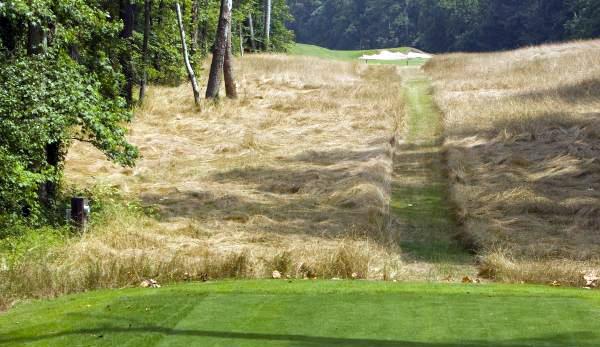Color And Invasive Species On The Golf Course
For decades, as I pursued affordable seasonal color with wildflowers, native grasses, ornamental shrubbery and ground covers, I worried about accidentally introducing dangerous, invasive species. Our region has a history of suffering invasive species, the worst being Kudzu, Fire Ants, General Sherman, Carpetbaggers and Bentgrass.
I abandoned the traditional golf course color platform--the formal tee-side annual flower bed--for two reasons: First, beds of summer begonias, spring tulips, and winter pansies were expensive . . . especially when all seven of our members capped their annual dues at $200.

Second, formal flower beds did not mesh well with my Rugged And Adventurous Tillinghastian golf course philosophy, as they tended more toward Candyassian golf.
Beginning in '84, I had a few successful attempts at introducing color and texture to the golf course through wildflowers and native grasses. I also had numerous failures . . . which I blame on trying to emulate Mark Hoban, without possessing sufficient science genes.
Our region has a history of suffering invasive species, the worst being Kudzu, Fire Ants, General Sherman, Carpetbaggers and Bentgrass.
During this phase, I cleverly deduced that color was seasonal and that colorful plants capable of blooming year round were kind of rare. (Yes, I realize if I had studied horticulture instead of Special Ops, I would have learned that much earlier.)
In '88, I ordered the world's supply of seeds and soon arrived at the following rules of Rockbottum CC Affordable Color Strategies:
1. Wildflower Field Size. Rather than try for the glorious, expansive Wizard of Oz fields of color, I concentrated small plots of color--about the size of a kitchen table--here and there amongst the native grasses. This improved maintenance efficiency, because areas not subjected to regular disturbances like mowing will allow Fire Ants, pine trees and sword-thorn vines to take up residence.
2. Aggressive Invasives. On two occasions, a large wildflower planting vanished. At first I suspected aggressive deer, but it turned out to be the much more aggressive Ladies Golf Association, procuring color for their table settings. This removed any chance of reseeding, but apparently the LGA did not study horticulture either.

3. Wildflower Success Rates. I carefully documented which wildflowers were compatible with my course's climate and what times of year they offered color. California Poppies and Ox-Eye Daisies were great in March, Lance-Leaved Coreopsis took over next and then Plains Coreopsis became our stalwart favorite. They often hung around until late summer, growing in poor soil, gravel parking lots and on car hoods.

4. Native Grasses. Our native grass tactics also came from spying on Hoban. He would fall-harvest golden broomsedge with a chainsaw, sprinkling seeds all about and providing a wonderful golden winter color that juxtaposed brilliantly with dark green overseeded fairways . . . another invasive species down here.

There is something hypnotic about the texture of varying shades of native grasses perched on a hillside overlooking a green, gently blowing in the wind. However, I wasn't able to grow anything but broomsedge. I tried Little Bluestem, Creeping Red Fescue, Sheeps Fescue--with mediocre results--and since we were in the middle of a three year drought in Georgia, I went big on Buffalo Grass in the out of play areas . . . and the rain returned.
(I'm not suggesting I caused the rain by planting Buffalo Grass, that would be ridiculous. I caused it by beginning a major greens rebuild project.)
5. Affordable Color/Erosion Control Ground Covers on steep banks, hillsides. Uh, never mind.
6. Beauty Shrubs. Just prior to my discovery of the Augusta Syndrome in '86, I contracted Azalea Poisoning and bought 300 azaleas while suffering from the fever. I then discovered their bloom peak was only three weeks, followed by 49 weeks of cleaning out plastic grocery sacks, dogwood leaves, and mylar balloons captured by azaleas.
This same sack-capture phenomenon also occurs in the ground cover known as Ileagnus, (uglyagnes) and juniper, (juniperus horribilus) but at lesser levels in Vinca Bee Flat Minor.
7. Color Trees. Our best consistent summer color came from Crepe Myrtle trees, with beautiful, huge pink and white and purple blooms. The Crepe Myrtle can be kept short, using Bonsai techniques, won't shade turf, impede golfers or root up cart paths like an asphalt mole.
8. Totally Native Areas. Win some, lose some. Golf TNA must be waaaay out of play, for they will eventually harbor large scary reptiles, giant spiders, and local bureaucrats trying to catch you irrigating non-essential areas like rough, bunker faces and greens. It is important to have a covert plan to maintain non-maintained Totally Native Areas. Golfer complaints could lead to another form of invasive species, the Customer Service Evangelist and their week-long indoctrination seminar.
Non-golf TNA might be out of your control, especially if the pro rents the course out to a local establishment of questionable repute, a situation that inevitably leads to extremely aggressive invasives.



0 Comments
Recommended Comments
There are no comments to display.